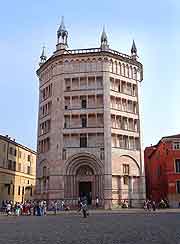Parma History Facts and Timeline
(Parma, Emilia-Romagna, Italy)

The earliest remnants of a civilisation in Parma are thought to be Celtic in origin. However, history suggests it is possible that the city was based on an even earlier Bronze Age settlement.
At any rate, it is known that Parma was founded as a Roman town in 183 BC. It was undoubtedly of strategic importance, because of its location on the Via Emilia, an ancient Roman road. The city's existence would also have strengthened Roman rule within the region of Cispadane, on the southern side of the Po River. The accomplished Roman town layout included a forum, theatre, amphitheatre, temple and also a basilica. It would even have boasted its very own urban water supply.
In the Byzantine period, which began in 553 AD, Parma was named Crisopoli. The origins of this name are still subject to debate, although it may have related to the town's importance as a financial centre. In 568 AD, following the Longobard invasion of the area, Parma became a major garrison.
In 870 AD, the town fell under the control of Bishop Guidobono. He was responsible for many new buildings, including the cathedral's chapter house, as well as the Bishop's Palace and seminary. The town was later conquered by the Longobards.
From the Middle Ages to the 16th Century
In 1106, Parma became an important city-republic. A cathedral and baptistery were built here at this time, amongst other grand structures. In the centuries that followed, the city fell to a succession of prominent families, from the Viscontis to the Sforzas. Finally, the Papacy gained control of Parma.
In 1545, the city became the capital of the state of Duchy of Parma and Piacenza, under the rule of the Farnese family. One of the most important buildings dating from this period of the city's history is the Palazzo della Pilotta, which today houses the Museo Bodoniano. Several schools of painting also began at this time. The most notable were those of Correggio and Parmigianino. Finally, in 1731, Bourbons took control of the city, bringing with them a period of peace and prosperity.
Modern History
During the Napoleonic Wars, Parma became part of the Taro Département. When the Congress of Vienna ended French rule, the city resisted the upheavals of the Risorgimento, a political movement that aimed to bring together the various Italian states. Instead, it simply passed back to the Bourbons.
In the second half of the 18th century, the city enjoyed something of an artistic revival. In particular, it fell under the influence of Marie Louise of Austria, the wife of Napoleon I. Of interest, she is said to have helped shape the city's new-found elegance. In 1860, Parma was annexed to Piedmont. A year later, it joined the newly formed Kingdom of Italy.
Fascism struggled to take hold in Parma in the early 20th century. Indeed, it was the only city in the region to resist calls to march to
Rome, an event that was organised in 1922 by Mussolini's Blackshirts.
During World War Two, the city was a centre for partisan resistance, with its rail network being a popular target for Allied bombing raids. In early 1944, many of its historic monuments were destroyed.
Parma was freed from its German occupation between 1943 and 1945. The resistance movement played a major role in its liberation. So too did the Brazilian Expeditionary Force, who fought alongside the Allied forces.
Today, Parma is famous for its art and architecture, although as far as tourism is concerned, it still remains something of an undiscovered gem for many.
 The earliest remnants of a civilisation in Parma are thought to be Celtic in origin. However, history suggests it is possible that the city was based on an even earlier Bronze Age settlement.
The earliest remnants of a civilisation in Parma are thought to be Celtic in origin. However, history suggests it is possible that the city was based on an even earlier Bronze Age settlement.